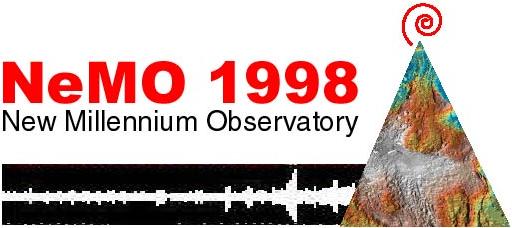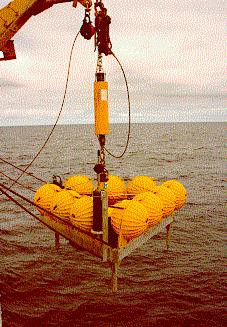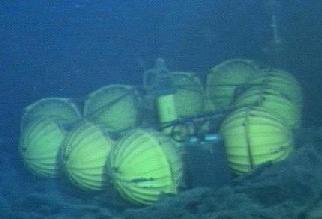WHAT'S NEW:
Eruption Confirmed!
New lava (rumbleometer stuck in flow) SE rift zone
(posted 9/1/98)
BACKGROUND:
Technology (ROV, ships, etc.)
Other 1998 Axial cruise reports
EXPEDITION:
Science Objectives
Calendar
Today's Science News
Participant Perspective
Teacher Logbook
EDUCATION:
Curriculum
Teacher Observations
Questions/Answers from sea
MULTIMEDIA:
(video clips, animations, sounds)

The Rumbleometer Story
A perspective from Chris Fox NOAA VENTS Program
Although I am not at sea with the NeMO expedition, I am VERY interested in their recovery of the seafloor Volcanic System Monitor better known as a "rumbleometer". In 1987, I deployed the first long-term instrument on Axial Volcano in hopes of capturing a volcanic eruption. The initial instrument consisted only of a pressure/temperature sensor. The experiment was designed to detect slow vertical movements of the seafloor associated with the withdrawal of magma during an eruption: so-called volcanic deflation. Axial Volcano, with its well defined summit caldera, seemed a perfect target. In the very first year, a significant 20-cm movement of the seafloor was interpreted to be due to deflation, but at that time there were no other sensors able to confirm the interpretation. In subsequent years, numerous smaller deflation events were detected but still without confirmation. Circumstantial evidence also indicated a large cold-water current associated with events, interpreted to be due to entrainment of surrounding water from a large megaplume.
 In 1992, the enhanced instrument called a rumbleometer was first emplaced at Axial. (Photo shows the 1992 deployment of the VSM off the NOAA Ship DISCOVERER (photo: A.Bobbitt NOAA)) This
instrument includes the pressure and temperature sensors of the original Bottom Pressure
Recorder, but adds tilt sensors to confirm ground deformation, a vertical seismometer to record
volcanic seismicity, and a current meter to record entrainment currents. The package consists of a
triangular metal platform with three legs about .5 meters long with very sharp spikes for feet to
allow good coupling to the seafloor. The instruments are housed in several pressure cases on top
of the platform, as is the acoustic release for recovery. The platform also includes ten glass
spheres encased in plastic "hard hats" to provide buoyancy for bringing the instrument to the
surface. Underneath the platform is a heavy (850 lb) steel railroad wheel that makes the
instrument extremely heavy in water (over 500 lbs). Most of the components (except the current
meter!) were field tested on land by lowering the package onto the flanks of the active eruption
at
Kilauea, Hawaii. Volcanic seismicity was detected from over 20 miles distance.
In 1992, the enhanced instrument called a rumbleometer was first emplaced at Axial. (Photo shows the 1992 deployment of the VSM off the NOAA Ship DISCOVERER (photo: A.Bobbitt NOAA)) This
instrument includes the pressure and temperature sensors of the original Bottom Pressure
Recorder, but adds tilt sensors to confirm ground deformation, a vertical seismometer to record
volcanic seismicity, and a current meter to record entrainment currents. The package consists of a
triangular metal platform with three legs about .5 meters long with very sharp spikes for feet to
allow good coupling to the seafloor. The instruments are housed in several pressure cases on top
of the platform, as is the acoustic release for recovery. The platform also includes ten glass
spheres encased in plastic "hard hats" to provide buoyancy for bringing the instrument to the
surface. Underneath the platform is a heavy (850 lb) steel railroad wheel that makes the
instrument extremely heavy in water (over 500 lbs). Most of the components (except the current
meter!) were field tested on land by lowering the package onto the flanks of the active eruption
at
Kilauea, Hawaii. Volcanic seismicity was detected from over 20 miles distance.
Two rumbleometers were deployed at Axial Volcano in Summer, 1997 from the RON BROWN. One was deployed at the central caldera site that has been occupied since 1987, and the other strategically located on the southeast rift zone, which geophysical information indicates to be the central focus of the subsurface magma body. This southeast rift zone is the site where the T-wave seismicity was first recorded from SOSUS in January, 1998. The nature of the T-waves indicate that this was a likely site for volcanic eruption. When the BROWN attempted to recover the two rumbleometers on Ron Brown Vents LEG I in July/August, the instrument from the central caldera released to the surface normally, but the instrument from the southeast caldera site did not!
Data from the central caldera were both disappointing and exciting... Disappointing because a power failure caused most of the sensors to fail after only a few days and well before the volcanic activity; Exciting because the pressure sensor DID record throughout and shows what appears to be more than 3 meters of subsidence associated with the January event! (click here for data diagram on this recovered instrument from 1998 Axial
The reason that the second rumbleometer did not release is now clear. It appears that it was engulfed by a lava flow and its feet are stuck in the hardened lava. The accompanying images from ROPOS show that the lava extends to just below the instrument platform.
| Photo shows rumbleometer on seafloor near the SE rift zone of Axial Volcano caldera. |

|
Plans are being formulated for attempting recovery by lifting the instrument with a chain attached to the ROPOS cage. I will be watching their progress anxiously. There is a high degree of risk that the instrument could be ruined during the recovery (if it is not already fried!), but the data does no good if it becomes a permanent part of the ocean floor!